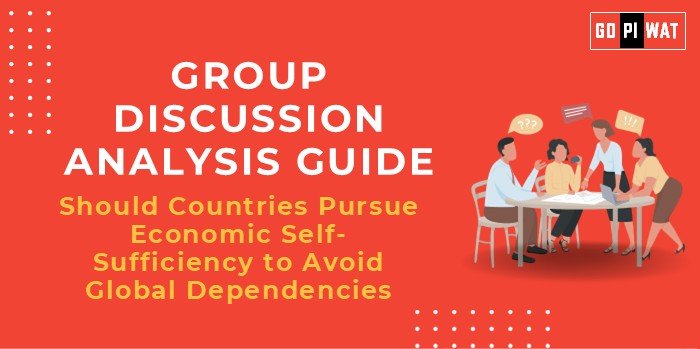📋 Group Discussion (GD) Analysis Guide
🌍 Should Countries Pursue Economic Self-Sufficiency to Avoid Global Dependencies?
💡 Introduction to Economic Self-Sufficiency
🌱 Opening Context: The COVID-19 pandemic and the ongoing geopolitical tensions, such as the Ukraine conflict, have highlighted vulnerabilities in global supply chains. Countries are increasingly considering strategies to achieve economic self-sufficiency to mitigate external risks.
📜 Topic Background: Economic self-sufficiency refers to a nation’s ability to produce goods and services to meet its internal demands without relying heavily on imports. The concept gained prominence during the mid-20th century but has resurfaced as countries navigate trade dependencies and geopolitical risks.
📊 Quick Facts and Key Statistics
- 📉 Global Trade Disruption (2023): $16 trillion worth of goods were delayed due to supply chain disruptions (WTO).
- 🌍 Dependency on China: 70% of global rare earth minerals are sourced from China, critical for electronics and renewable energy sectors.
- 🍞 Food Security Risks: 34 nations rely on imports for over 50% of their food requirements (FAO).
- 💡 Oil Dependence: Countries importing over 80% of their oil face heightened economic risks due to price volatility.
🌍 Stakeholders and Their Roles
- 🏛️ Governments: Develop policies and investments in self-reliance (e.g., India’s Atmanirbhar Bharat).
- 🏢 Private Sector: Innovate local manufacturing technologies and diversify supply chains.
- 🌐 Global Organizations: Facilitate dialogue on balancing globalization with local resilience.
- 👥 Citizens: Drive demand for locally-produced goods.
🏆 Achievements and Challenges
🌟 Achievements:
- ✔️ Localized Manufacturing Growth: Nations like Vietnam have seen a 15% annual increase in domestic production since 2020.
- 🔋 Renewable Energy Independence: The EU has ramped up local solar manufacturing, reducing dependency on imports by 20% in 2023.
⚠️ Challenges:
- 📈 Higher Costs: Domestic production often raises consumer prices by 10-30%.
- ⚙️ Technological Gaps: Dependence on imported machinery undermines self-reliance goals.
🌍 Global Comparisons:
- 🇯🇵 Success: Japan’s focus on domestic automation has reduced its dependency on Chinese electronics by 12%.
- 🌍 Challenges: African nations face logistical and financial constraints in reducing food import reliance.
📜 Case Studies:
- 🇮🇳 India’s Atmanirbhar Bharat: Increased local production but struggled with cost efficiency in the electronics sector.
✨ Structured Arguments for Discussion
- 💬 Supporting Stance: “Economic self-sufficiency fosters resilience against global crises, ensuring critical sectors like food, energy, and healthcare are safeguarded.”
- ⚖️ Opposing Stance: “Overemphasis on self-sufficiency can isolate economies, reducing their competitiveness and access to advanced technologies.”
- 🔄 Balanced Perspective: “While self-sufficiency is vital in critical sectors, a hybrid approach combining globalization with local resilience is optimal.”
🎯 Effective Discussion Approaches
📖 Opening Approaches:
- 📊 “With 70% of rare earths sourced from a single country, global trade vulnerabilities are glaring.”
- 📜 “India’s push for local manufacturing highlights the challenges of balancing costs with independence.”
🔄 Counter-Argument Handling:
- ✔️ “While self-sufficiency raises costs, subsidies can offset immediate burdens on consumers.”
- 🌍 “Rather than isolation, selective decoupling in sensitive sectors strikes a balance.”
📈 Strategic Analysis of Strengths and Weaknesses
- 💪 Strengths: Enhances national security; reduces dependency risks during crises.
- ⚠️ Weaknesses: Increased production costs; limited scalability in smaller economies.
- 💡 Opportunities: Growth in local industries; export surplus potential in the long term.
- 🚨 Threats: Global trade retaliation; technological stagnation without external collaboration.
📚 Connecting with B-School Applications
- 🌟 Real-World Applications: Self-sufficiency strategies as project themes in supply chain management and sustainable development.
- 💬 Sample Interview Questions:
- “How can self-sufficiency align with sustainable development goals?”
- “What role do public-private partnerships play in achieving economic independence?”
- 📖 Insights for B-School Students:
- Explore the balance between globalization and local growth.
- Analyze case studies of economic policy impacts in crises.


